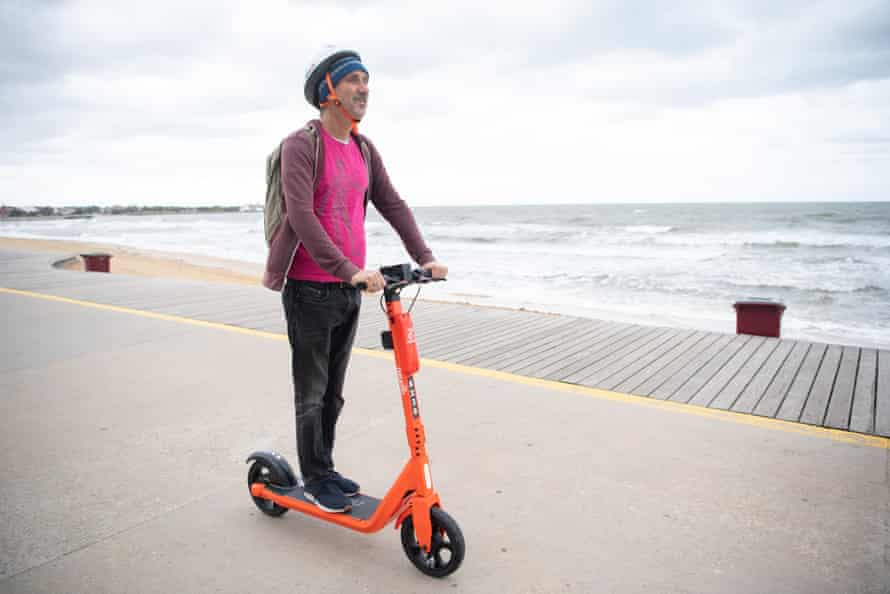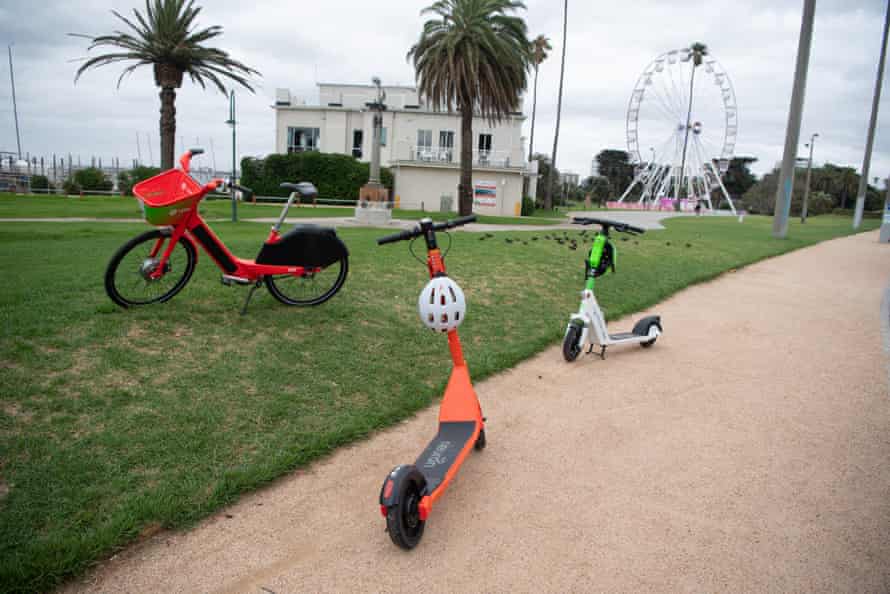Liberating but limited: road testing Melbourne’s new e-scooter rental scheme
Melbourne has a history of micro-mobility failures. Can the Lime and Neuron e-scooters turn the tide?

Residents of the inner municipalities of Melbourne, Yarra and Port Phillip woke this week to bands of flame orange and fluoro green e-scooters adorning local street corners, tram stops and back roads – like small armies of benevolent Daleks.
As part of a 12-month trial, 1,500 rentable Lime and Neuron e-scooters have been placed around the three LGAS. They have a maximum speed limit of 20km/h, and their usage will be restricted to bike lanes, shared paths and low-speed roads.
Melburnians could be forgiven for having a rather sceptical view on the viability of shared micro-mobility programs, since, as Dr Elliot Fishman, director of the Institute for Sensible Transport, put it: “Melbourne doesn’t have a particularly successful history of running these schemes.”
Those past failures, include the “blue-bikes” scheme that ran from 2010 to 2019 before being pulled off the roads due to poor uptake – at a cost of around $2m per year in public subsidies – and the disastrous O-bike scheme. The bright yellow bikes that were famously, frequently thrown into the Yarra River or hoisted up trees, before the company leasing them eventually went bankrupt.
The Port Phillip mayor Marcus Pearl says the council has “learnt a lot from the O-bike experience”.
He cites the guidelines set out for current e-bike schemes, including no-ride, no-parking and slow zones, and says “while we cannot control the behaviour of individuals, the strict guidelines … have proven effective during this ongoing trial”.
“Similar principles for the management of shared e-scooters have been included in the agreement with shared e-scooter operators,” he says. And, “as with the shared e-bikes, the operators will be responsible for all costs associated with e-scooter recovery from parks and waterways”.
E-scooters come with their own baggage too. In Canberra and Brisbane, they have been met with vociferous opposition and, in Hobart, two city councillors have called for a suspension of the city’s current e-scooter trial amid safety concerns.
Internationally, safety issues have also come to the fore. In Paris the use of e-scooters was restricted after a fatal incident involving a pedestrian in June 2021. London has also recently banned them from being brought on to public transport after a spate of battery fires led to vehicles combusting.

Still, as an e-scooter virgin, I was keen to give them a spin.
After scanning the QR code through the Neuron smartphone app, a mellifluous female voice instructs me to “test the brakes” and provides a gentle reminder that “riding isn’t permitted on footpaths” followed by a cheery bell sound. I removed the helmet from its clip-in holster and hit the road.
As an avid e-bike rider, the first thing I noticed is that these scooters feel relatively slow and stable to ride, and much heavier than I’d imagined. They are completely GPS-operated, meaning the scooters slow down in slow traffic zones, and simply power off when ridden into no-riding zones such as heavily pedestrianised malls.
But after spending a few days scooting around the quiet tree-lined backstreets and beachside bike paths of St Kilda, I realised there is something liberating about being able to simply step on to an e-scooter and ride for as long (or short) a distance as I required. It feels like the start of a tiny-wheeled transport revolution.
READ RELATED: The Bachelorette's Jarrod Woodgate reveals his battle with mental illness
One of the positives about the rental scheme is the cost – 45c a minute with a $1 activation fee makes them pretty accessible for short trips. I rode from my home to the beach, a journey that would take about 15 minutes to walk, in about five minutes – costing a grand total of $3.25.
Learning the ropes of riding was a matter of trial and error – for example, you have to park them in designated parking areas, which means checking the map before you head off, so you know where to end the trip. This also means they won’t be as likely to end up blocking pavements which has been a problem, particularly for people with mobility issues, in other cities. If you’re like me, you will probably ride into no-ride zones once, and learn to avoid them on future rides.

A more serious current restriction is that the devices are a nodal transport system – meaning they will only operate within particular areas. At present it isn’t possible to ride from St Kilda to Chapel Street, for instance, because the adjoining municipality of Stonnington isn’t part of the trial.
This worries Fishman, who says “one of the things that will end up minimising the success of these schemes is the lack of connected bike infrastructure and lack of connected slow streets.”
“In a city of five million people, in Melbourne we still don’t really have enough of those to make this a solution that most people would consider for themselves.”
But he does see promise. “It is part of a transition that a lot of global cities are going through to try to reduce the impact of people’s mobility on things like emissions, road safety and congestion.”

Locally, opinions are divided about the arrival of the e-scooters. When I canvassed opinions on a St Kilda residents group, some people immediately branded them a “menace”. One local resident, Tamahine Willenberg, commented that “the trial allowing them on shared paths is a disaster waiting to happen … 20kph is just too fast for shared path”.
However, other locals were supportive. St Kilda resident Paul Jonathan said: “The more people we can get out of cars, the safer our roads are. We also urgently need to reduce transport emissions due to the climate emergency.”
According to Dr Alexa Delbosc, a senior lecturer in transport engineering at Monash University, that’s the key benefit of e-scooters: they provide a genuine alternative to help people travel without cars in congested urban areas.
“The challenges around safety and suitability are the same that cyclists face every day. But if programs like this make more people interested in scooting, it provides even more reason to roll out safe infrastructure for people on bikes or on scooters,” she says.
Fishman agrees. He says the trial’s success or failure will come down to its scale and cost.
“I think the expansion … to cover the whole city area is the thing that is going to make it work,” he says. “At the moment it is quite restricted. It is also crucial that the pricing of these schemes is such that it allows people to use them as a regular means of transport rather than just a one-off.”
Ultimately, Fishman says, e-scooters are taking up public space, “so they need to provide a public good”.
Source: Health & wellbeing | The Guardian




